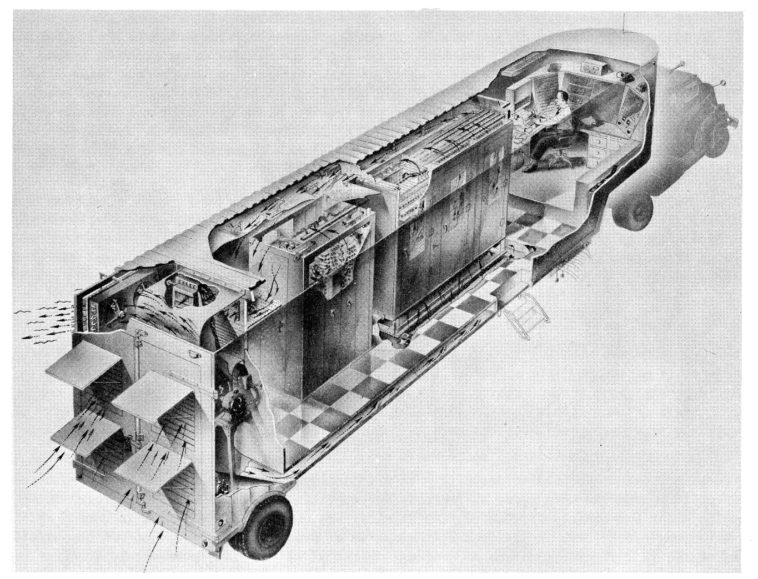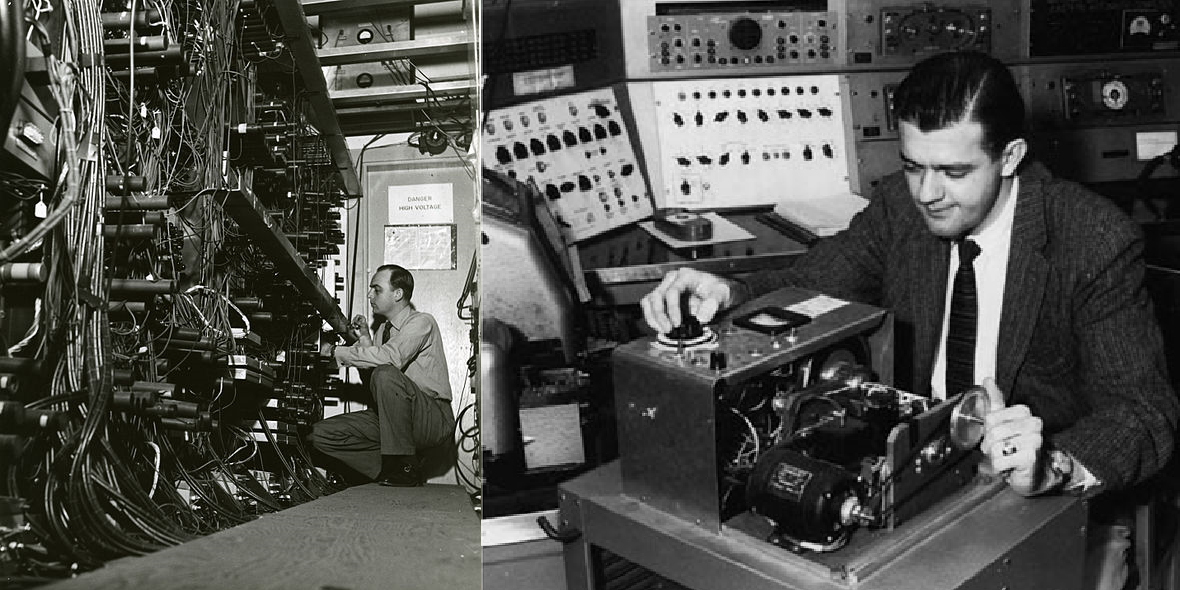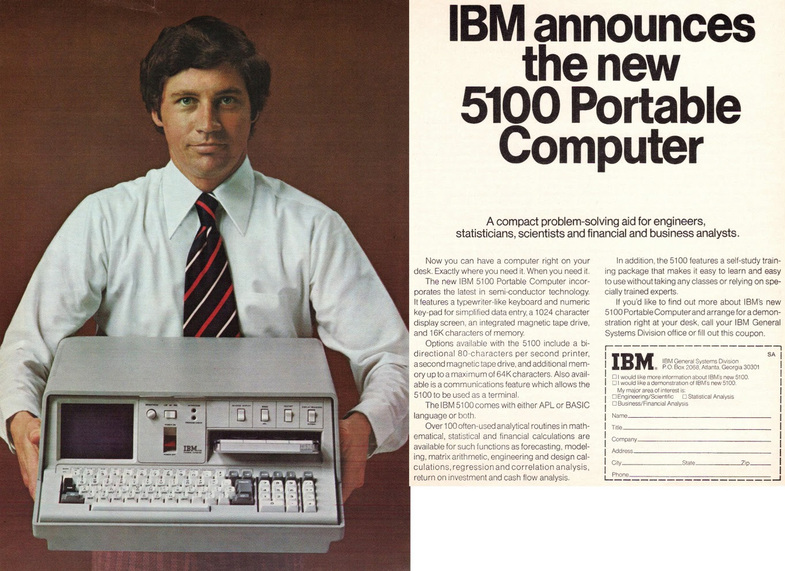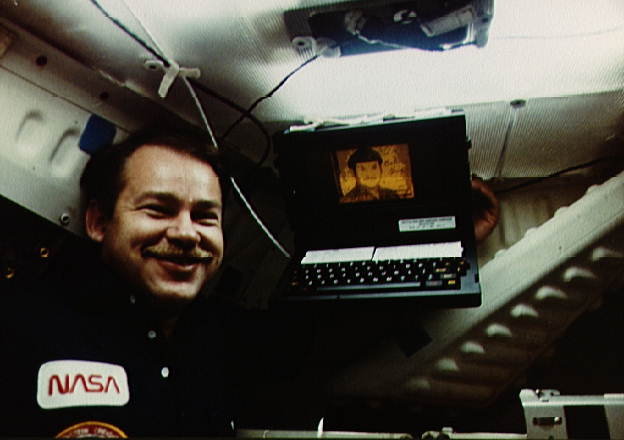 This is one of the two elements of DYSEAC, a mobile computer, which was one of the most advanced computing systems of its time.
This is one of the two elements of DYSEAC, a mobile computer, which was one of the most advanced computing systems of its time.One of the most significant achievements of the last century - the creation of computers. For its time, many of them were real computing monsters. But at the same time they looked like monsters: huge, heavy, occupying several rooms or even floors. In the 1950s, the idea of creating a mobile computer that could be transported, if necessary, in order to carry out calculations directly at work, a nuclear industry enterprise, or a scientific organization came to someone’s bright mind.
As is often the case, the need for laptops came first from the military. With their full support, the National Institute of Standards and Technology of the USA began work on the creation of the world's first portable (although in this case it would be more correct to use the word “mobile”) electronic computer. Its basis was the earlier development of the institute, which its employees created in the early 50s.
The mobile system, called
DYSEAC , was located in two trailers and weighed 20 tons. In the trailer number 1 were placed the control panel, data input-output, storage of information and a 12-ton cooling system. The second trailer housed the power supply system, the cooling system and there was also free space. The weight of the second trailer was, respectively, 8 tons.
The size of the mobile installation can be explained by the desire of the creators of the mobile computer to achieve parity in the characteristics with another computer. It's about
SEAC , nicknamed "The Giant Brain." This system could multiply or divide 11-digit numbers in just 250 microseconds. The system was described by the creators as the most powerful of all that worked at that time. It is not necessary, however, to forget that this computer
worked in the 50s .
SEAC features
It is not surprising that her contemporaries attached so much importance to her. She allowed to perform a series of complex operations in a matter of seconds or hours, while manual calculations of the same volume took many days, if not weeks. It is worth noting that the creators of SEAC were not too pleased with the attention that the public paid to computers, but nothing could be done about it.
Semiconductors (mainly diodes) have already been used in computers. Of course, the lamps were there too. Wikipedia
tells us about this computer as follows: “SEAC, created on the basis of EDVAC, used 747 vacuum tubes (a relatively small number compared to most computers of that time), the number of which was increased to 1,500 pieces over time, and 10,500 germanium diodes, the number of which over time, it was increased to 16,000. It was the first computer, most of the logical circuits of which were built from semiconductor devices. Lamps were used as signal amplifiers, inverters, and dynamic triggers. ”

The specified computer could store 512 words in memory. Two types of memory were used as the main ones: static in the form of Williams tubes and 64 delay lines, where words were stored, each 45 bits. With the help of the switch, it was possible to select the memory that was needed at a particular moment. The processor clock frequency was 1 MHz. A system of a relatively small number of vacuum lamps supported 11 types of instructions. The data storage was large enough - about 1.8 * 2.1 meters. By the way, it was with this computer that a photo scanning device was first used.
The SEAC command system was 4-address (2 addresses of the operands, the address of the result record, the address of the next command). As for the 11 types of instructions that have already been mentioned, they were: integer addition, subtraction, multiplication, division, comparison and input-output, and later was expanded to 16. The execution time of the addition operation was 864 μs, and the multiplication time was 2980 μs (i.e. almost 3 ms).
It was used to solve problems such as:
- meteorology
- linear programming
- optical lenses
- calculations for the National Laboratory in Los Alamos for a thermonuclear bomb [2]
- navigation tables for radionavigation system LORAN
- statistical sampling plans
- helium atom wave function
- proton synchrophasotron design
What could DYSEAC?
DYSEAC, the mobile computer, used SEAC as the basis. The difference, of course, was, first of all, constructional. In particular, when creating DYSEAC used printed circuit boards. As far as can be judged, this was the first case of using boards of this type. They facilitated the work of the creators of computers and allowed to assemble the end device faster than usual.
There were more opportunities for DYSEAC than for the original model. In particular, the computer could perform 16 types of operations. Five of them coincided with SEAC, five more were different variations of the original operations of the first powerful computer and another six
were completely new . A distinctive feature of the computer was that despite the large number of constituent elements, including moving, computers rarely failed.
The computer used the original parts of SEAC, which were placed in such a way as to take up less space and ensure the possibility of creating a mobile vehicle. The entire infrastructure was divided into elementary elements that formed larger blocks. In order to build a full-fledged computer out of all this, careful control of the work was necessary - just so that the parts are not mixed up. Any of us who have ever collected something complicated from dozens, hundreds or thousands of parts, understands what difficulties may arise if something is confused.
All sorts of ideas implemented in the design of a mobile computer, and used later. Some of them, including printed circuit boards, are widely spread in modern times. Among other things, the computer was able to interact with other computers in real time. This can be called an early prototype of a cluster computing system. In 1956, SEAC and DYSEAC were combined into a single system as part of an experiment.
The ability to connect to other systems appeared precisely at DYSEAC - it was a novelty that gave a lot to the new era of information computing.
The process has begun
After just a few years, the same military decided to create a more mobile version of DYSEAC. By that time (and it was about 1956), both printed circuit boards and semiconductor elements became popular. As a result, the company Sylvania, which offered the best conditions for the implementation of the contract, developed MOBIDOC. It was almost the same as DYSEAC in terms of system performance, but it was placed not only in two trailers, but only in one. The project was approved by the military, who began to actively use it - MOBIDOC was actively exploited until the 1960s.
In 1958, Autonetics created RECOMP II, a truly portable computer, about the size of a modern oven. The volume of the system is 133 liters. The computer weighed 90 kg. Because of this, it can be called already portable, and not just mobile. It was real progress. The company that developed it, positioned RECOMP II as “a portable digital computer capable of solving problems at the place of their appearance.”
By the way, RECOMP II was already more productive and more functional than the computer, which was located in two trailers. In particular, 4,096 words were already stored in the ROM, and not 512. Some accessories could be connected to the system, further expanding its functionality. The cost of the computer
was $ 95,000 at the time of the announcement.

Well, the ancestor of all modern PCs can be considered the IBM system, which is called
SCAMP . Then came the model IBM 1500, 5100 and others. They were not particularly light, but compared to trailers or even an oven, this was real progress - only 22 kg with much higher characteristics.

Osborne 1 can also be considered a portable computer; this is one of the first such systems to go into mass production. The computer had a suitcase form factor (yes, it was a suitcase). On one side of the case there was a carrying handle, and the keyboard was located on the flip cover, which folded protected the display with a diagonal of 5 inches. To the left and right of the display were two floppy drives for 5.25-inch floppy disks. Its cost, in comparison with the price of other similar systems, was very democratic and was only $ 1,795. It was a much more significant amount than today, but all the same, it was lifting not only for large corporations, but also for ordinary users (although the person who considered it necessary to purchase such a PC at that time was hardly an ordinary user).
 Grid Compass orbiting the Earth pleased astronauts with their capabilities
Grid Compass orbiting the Earth pleased astronauts with their capabilitiesOne of the first computers in the form factor of a modern laptop was the
Grid Compass . This is a miniature (compared to other PCs of the time) computer equipped with an Intel 8086 processor, an electroluminescent display of 320 * 240 pixels, a 340 KB ROM and a 1200 baud modem. It was possible to connect hard disks and floppy disks via the IEEE-488 interface (also known as (GPIB - General Purpose Instrumentation Bus). The device weight was 5 kg. Compass had its own operating system, which was called GRID-OS. Naturally Compass was not inexpensive. Its cost at the time of release ranged from $ 8,000 to $ 10,000, depending on the configuration, although the buyer was mainly the US government, NASA and the military. In the early 1980s, Pervono-laptop even flew into space.
Well, with what happened in the field of portable computers further, we are all well (or at least satisfactorily) familiar. The entire recent history of PCs and laptops gave rise to precisely these retro-systems, which were a breakthrough for their time. Modularity, relative mobility and (a little later) portability - this is all that we can see in modern technology. The foundations were laid precisely then - in the last century. Now humanity is only perfecting the ideas that were proposed several decades ago. Now that what can be called a breakthrough, no.